You are currently browsing the tag archive for the ‘CEO’ tag.
Last year Ventana Research released our Office of Finance benchmark research. One of the objectives of the project was to assess organizations’ progress in achieving “finance transformation.” This term denotes shifting the focus of CFOs and finance departments from transaction processing toward more strategic, higher-value functions. 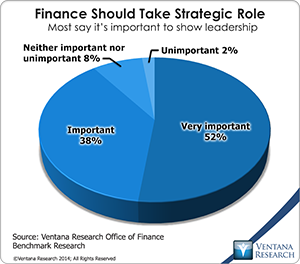 In the research nine out of 10 participants said that it’s important or very important for the department to take a more strategic role. This objective is both longstanding and elusive. It has been part of the conversation in financial management circles since the 1990s and has been a primary focus of my research practice since its inception 12 years ago. Yet our recent research shows that most finance organizations struggle with the basics and few companies are even close to achieving this desired transformation.
In the research nine out of 10 participants said that it’s important or very important for the department to take a more strategic role. This objective is both longstanding and elusive. It has been part of the conversation in financial management circles since the 1990s and has been a primary focus of my research practice since its inception 12 years ago. Yet our recent research shows that most finance organizations struggle with the basics and few companies are even close to achieving this desired transformation.
Today, finance transformation is not only even more necessary but also increasingly achievable. Advanced technology now can equip management teams with more powerful competitive capabilities. Its availability has raised the bar for everyone in business. Technology changes the terms of engagement, expands available marketing channels, alters consumer preferences and revolutionizes business models. The overabundance of hype when it comes to the popular treatment of information technology can obscure its usefulness in business. One of the most serious challenges for executives – especially in the Office of Finance – is to understand the practical application of information technology, neither embracing fads nor ignoring opportunities with real economic and competitive benefits.
Business computing tools continues to evolve in ways that make it more user-friendly and more affordable than ever, and thus it can assist in achieving finance transformation. The “consumerization” of business applications is now well established, as software vendors adapt technology to enable their software to adapt to the needs and preferences of users. Moreover, as technologies such as in-memory processing and big data analytics find increasing use in business, savvy executives will adjust their management practices to use them to their advantage. In-memory computing, for instance, makes it practical to easily engage in a numbers-based dialog for planning, tactical analysis and performance insights.
In my experience, this persistent focus on mechanics is necessary because relatively few finance and accounting organizations make effective use of available and affordable technology. Instead, a majority spend too much time “fighting fires,” many of which are the result of not using capable technology. To get beyond this situation, CFOs and controllers must evaluate their existing IT systems with an eye to using them to automate repetitive tasks and speed execution of cross-departmental functions. Doing that can free up time and money better spent on activities that return value, such as more insightful and actionable analyses or more accurate forecasting and planning. Our new research agenda for the Office of Finance attempts to balance the leading edge and mainstream use to help businesses find practical solutions.
Ventana Research’s Office of Finance practice uses two key criteria to select a research topic: It must have pressing relevance to finance executives as a means to improve their company’s performance, and information technology can play a role in addressing the issue. Our research agenda for 2015 emphasizes three broad technology-related themes serving the goal of finance transformation:
- The use of software and other information technologies to expand and extend the department’s capabilities
- More effective execution of the finance function
- Using IT to make it easier to implement change.
Within each of these three themes we will be exploring a range of important topics.
First, to address basic requirements, we’ll look at the application of financial performance management (FPM) to help improve results. Ventana Research defines FPM as the process of addressing the often overlapping issues that affect how well finance organizations support the activities and strategic objectives 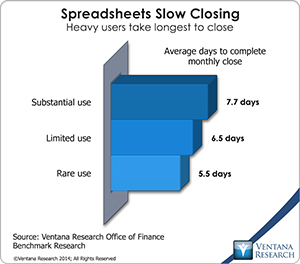 of their companies and manage their own operations. FPM deals with the full cycle of the finance department’s functions, including corporate and strategic finance, planning, forecasting, analysis, closing and reporting. It involves a combination of people, processes, information and technology. In each of these, not using the appropriate technology has a significant impact on how well a company performs. For example, spreadsheets are an essential technology for finance departments but often are used inappropriately. Our research shows that on average companies that use them substantially in managing their financial consolidation and close take more than two days longer to complete the process than those that use them rarely. Spreadsheets are often used to address the symptoms – not the causes – of technology issues. But automation through software dedicated to such tasks can eliminate the need for repetitive steps such as allocations and reconciliations or address the root causes of data that is hard to access, inconsistent or inaccurate.
of their companies and manage their own operations. FPM deals with the full cycle of the finance department’s functions, including corporate and strategic finance, planning, forecasting, analysis, closing and reporting. It involves a combination of people, processes, information and technology. In each of these, not using the appropriate technology has a significant impact on how well a company performs. For example, spreadsheets are an essential technology for finance departments but often are used inappropriately. Our research shows that on average companies that use them substantially in managing their financial consolidation and close take more than two days longer to complete the process than those that use them rarely. Spreadsheets are often used to address the symptoms – not the causes – of technology issues. But automation through software dedicated to such tasks can eliminate the need for repetitive steps such as allocations and reconciliations or address the root causes of data that is hard to access, inconsistent or inaccurate.
Similarly, ERP systems are a core technology that supports finance operations. Forward-looking finance executives must take into consideration more than just the difficulty and cost of implementing and modifying these systems. A reluctance to make timely changes to ERP systems poses cost and risk issues of its own. Organizations that are have shied away from cloud-based ERP also should re-examine their assumptions for doing so.
ERP is a mature category, yet there are some business models and methods that most ERP systems do not handle well. The Office of Finance practice will be paying greater attention to areas such as configure, price and quote (CPQ) applications as well as recurring revenue software. Companies that offer subscription-type services (as their core business or one that contributes a significant share of revenues) will find it valuable to automate the quote-to-cash process as an end-to-end process, including control of the data created by and used in the process.
To strengthen its core capabilities, several technologies are particularly important to the Office of Finance. One, mentioned above, is in-memory computing. Because of its ability to rapidly process computation of even complex models with large data sets, in-memory computing can expand the range of planning, budgeting, forecasting and reviewing. It enables organizations to run more simulations to understand trade-offs and the consequences of specific events, as well as change the focus of reviews from what just happened to what to do next. For these reasons, in-memory computing also may encourage more companies to replace desktop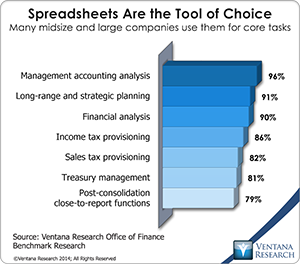 spreadsheets (which have practical limits to the size, complexity and adaptability of the models that are created in them) with dedicated planning applications that can harness the power of in-memory processing.
spreadsheets (which have practical limits to the size, complexity and adaptability of the models that are created in them) with dedicated planning applications that can harness the power of in-memory processing.
More effective use of technology also means replacing spreadsheets used in repetitive collaborative enterprise processes with dedicated applications. Our recent business planning research reveals that a majority of midsize and larger companies continue to use spreadsheets for planning, forecasting and budgeting – and these companies continue to suffer the consequences, such as an inability to do effective contingency planning or drill down into underlying data to have visibility into root causes of opportunities or issues. People recognize that spreadsheets have shortcomings, but they rationalize their use because of their familiarity and convenience. Our research shows that many aren’t aware of the various categories of affordable and relatively easy to use software that provide a range of capabilities unavailable in spreadsheets. Those capabilities can go a long way toward making Finance more strategic.
For instance, predictive analytics is a technique that companies can utilize to achieve better results. It can be used to create more accurate or nuanced projections of future outcomes and is especially useful in quickly finding divergences from expectations to create more timely alerts. For instance, rather than having to wait until the end of a month to look at actual results and then initiate a course of action, early in the month a corporation could use predictive analytics to spot and address a probable revenue shortfall in a specific product line or to change production rates or shipments to avoid a likely regional stock-out caused by demand that is stronger than expected. Predictive analytics increasingly is embedded in planning applications.
Other, more specialized software tools also can promote a more effective finance function, and executives must focus on acquiring and using those that enable the department to take a more active role in improving performance in the company’s operations. Finance has the necessary analytical talent and is positioned to be a neutral party in balancing the requirements of different functional groups or where issues cross business units or geographic boundaries. For example, software that helps manage pricing and profitability is spreading from hospitality, transportation, retailing and consumer financial services to other areas, especially business-to-business industries. Used properly, this type of software enables a company to tailor its control of individual decisions regarding pricing, discounts and other terms to achieve the results best suited to its strategy. It can continuously make adjustments consistent with longer-term objectives in response to market conditions. Similarly, companies increasingly use expense management systems to gain greater control over aggregate spending and vendor selection. These sorts of systems can provide controllers and treasurers with greater forward visibility into future outlays, ensure volume discounts are utilized and honored, and help streamline the accounts payable process to earn early-payment discounts.
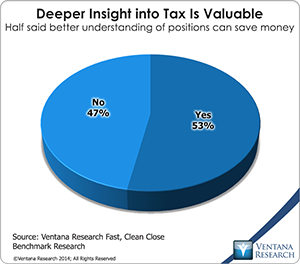 Another operational area, taxation, incurs some of a company’s biggest expenses, yet direct (income) tax management is still in its infancy. Here also, most organizations use desktop spreadsheets to manage their direct tax analytics and provisioning, a time-consuming process that fails to deliver transparency or the ability to manage tax risk exposure effectively. They would do better with technology more conducive to a strategic approach to managing income taxes. Half the companies in our research said that having deeper insight into their tax positions could save them money. A growing list of software is available to make the tax provisioning process faster and more visible, enabling companies to make better decisions about the timing and aggressiveness of their tax positions. In addition, all larger and some midsize corporations can benefit from a dedicated tax data warehouse to support the automation of tax planning and provisioning.
Another operational area, taxation, incurs some of a company’s biggest expenses, yet direct (income) tax management is still in its infancy. Here also, most organizations use desktop spreadsheets to manage their direct tax analytics and provisioning, a time-consuming process that fails to deliver transparency or the ability to manage tax risk exposure effectively. They would do better with technology more conducive to a strategic approach to managing income taxes. Half the companies in our research said that having deeper insight into their tax positions could save them money. A growing list of software is available to make the tax provisioning process faster and more visible, enabling companies to make better decisions about the timing and aggressiveness of their tax positions. In addition, all larger and some midsize corporations can benefit from a dedicated tax data warehouse to support the automation of tax planning and provisioning.
The third area where technology can help senior executives achieve better results is in implementing fundamental changes in business management. For example, our benchmark research on long-range planning demonstrates that better management of technology and information can improve alignment between strategy and execution. As well, far from simply being a technology concern, cloud computing enables corporations to cut costs and gain access to more sophisticated technology than they could feasibly support in an on-premises deployment. Using effective technology can boost performance. The improper use of spreadsheets as seen in our research continues be an unseen killer of corporate productivity because they have inherent defects that significantly reduce users’ efficiency in these tasks. Increasingly companies have inexpensive options that are easier to use and enable more advanced, reliable modeling, analysis and reporting. Finance organizations are usually involved in developing scorecards to assess performance. In developing and applying balanced scorecards, companies must incorporate operational risks to the mix of measures. Managing operational risk outside of financial services is still hit-and-miss, as our benchmark research on governance, risk and compliance shows. Nonfinancial businesses rarely manage risk well, usually because they do not measure risk explicitly and therefore do not formally consider it as a trade-off in making decisions.
Another component of our 2015 research agenda is the Ventana Research Value Indexes – detailed evaluations of vendor software offerings in specific categories. We carefully assess an exhaustive list of product functionality and its suitability to task, product architecture and the effectiveness of vendor support for the buying process and customer assurance. Each Value Index represents the value a vendor offers and relevant aspects of its products and services for users. This year again we will assess financial performance management suites and introduce a new Value Index for business planning software to complement our benchmark research.
Information technology is an essential element of business management. Yet many senior executives and managers have too narrow and too limited an understanding of IT’s full potential, much as those managing corporate information technology usually don’t appreciate business issues and how IT can address them. The business/IT divide is a barrier that prevents many companies from achieving their performance potential. The divide need not exist. Business executives don’t have to be able to write Java code or master the intricacies of an ERP or sales compensation application. However, CEOs and executives should master the basics of IT just as they must understand the fundamentals of corporate finance, the production process and – at least at a high level – the technologies that support that process. My research agenda for 2015 that you can download continues to focus on the major issues in which technology plays a key role in addressing key issues that confront businesses. Please follow my analyst perspectives this year as I continue to focus on the practical use of information technology to improve the effectiveness of finance and accounting professionals.
Regards,
Robert Kugel
SVP Research


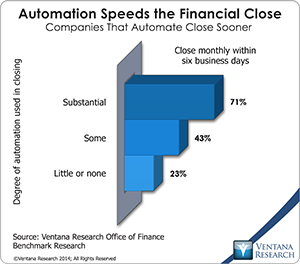
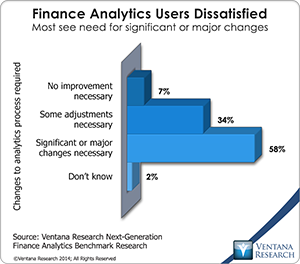
 Klout
Klout LinkedIn
LinkedIn Plaxo
Plaxo Twitter
Twitter Facebook Fan Page
Facebook Fan Page Facebook Group
Facebook Group Ventana Research Website
Ventana Research Website